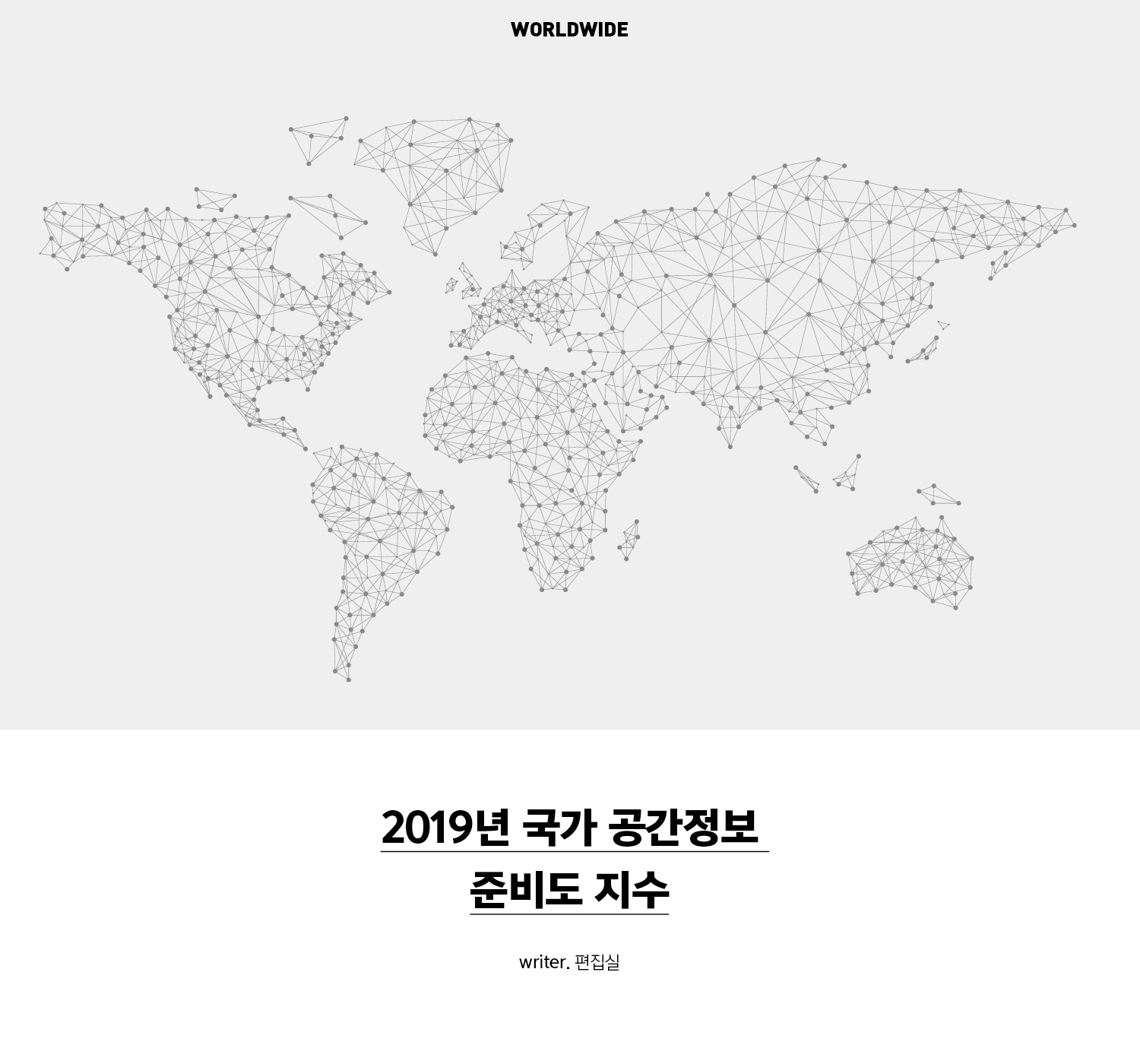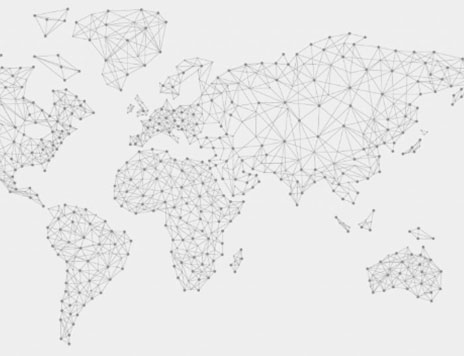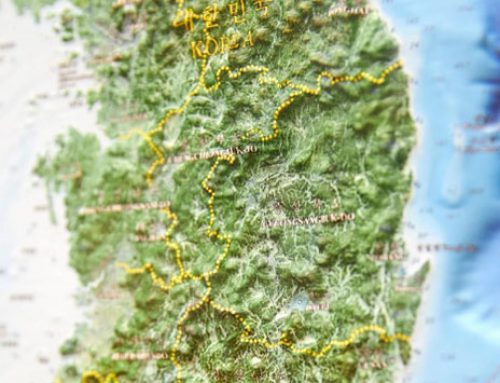
‘Geospatial Media and Communications’에서 2019년 국가 공간정보 준비도 지수(이하 CGRI-19)를 발표했다. 이번 발표는 2017년 이래 세 번째로 꼽힌다. 또한 이 발표는 의사결정자와 이해관계자가 해당 국가의 현황이 다른 국가 대비 어느 수준인지 파악할 뿐만 아니라 공간정보 산업이 제대로 발전하고 있는지 살피는 객관적 평가 기준으로 활용된다. 그 자세한 내용을 지역별로 살펴본다.
북미 지역
▼
North America region
▼
이런 면에서 미국과 캐나다는 각각 국가 차원에서 공간 데이터의 공동 사용을 강화하기 위한 조치를 지속적으로 추진하고 있다. 올해 CGRI-19 정책 프레임워크 순위에서 미국이 영국을 밀어내고 1위를 차지하게 된 가장 중요한 이유 하나를 꼽으라면 단연 의회의 2017년 공간정보데이터법(Geospatial Data Act 2017) 승인이다.
여기에 2018년 발표한 국가우주전략은 2004년에 발표한 기존 공간 기반 포지셔닝, 탐색 및 타이밍 정책과 2003년에 발표한 상업용 원격 감지 공간 정책에 더해 확실한 정책 기반을 구축했다. 캐나다도 뒤쳐지지 않기 위해 공간정보 운영 정책을 수립하고 있으며 캐나다우주국은 우주 관련 전략을 준비하고 있다. 멕시코와 코스타리카는 명확하게 정의된 정책 구비 면에서 좋은 점수를 받긴 어려웠다.
In this respect, USA and Canada both continued to take necessary steps to strengthen the collective use of spatial data in the country. If there was one single cause that could be attributed to USA dethroning the UK from the top position on the CGRI-19 Policy Framework pillar this year, it was the clearance of the Geospatial Data Act 2017 by the US Congress.
Also, the announcement of the National Space Strategy in 2018 added definite layers to the country's existing Space-Based Positioning, Navigation and Timing policy (2004), and the Commercial Remote Sensing Space Policy (2003). Not far behind is Canada, with its own Geospatial Operation Policy in place and a Space Strategy by the Canadian Space Agency in pipeline. With regard to having a well-defined and documented policy, both Mexico and Costa Rica fail to impress.
미국은 CGRI-19 데이터 인프라 기반 평가에서도 우위를 점하고 있다. 미국은 지적, 지형, 유틸리티 네트워크, 전송 네트워크와 같은 주제별 고해상도(1:200-1:1,250) 레이어 같은 풍부한 자산을 보유하고 있으며, 이런 자산들은 거의 매월 업데이트되고 있다. 또한 미국은 지구 관측 분야의 리더이며 자체 위성 기반 포지셔닝 시스템을 보유하고 있기도 하다. 미국은 이 분야 개척자이자 선도자로 꼽힌다.
캐나다가 미국의 행보를 열심히 따르고 있는 사이 멕시코와 코스타리카 두 신흥국들은 몇 년 전에 국가공간정보인프라(NSDI) 구축 과정을 성공적으로 시작할 수 있었다. 이 두 국가들은 지구 관측 관련해 ISRO, CNES, NASA와 같은 우주탐사기관과 협력 계약을 체결하는 등 능동적인 의지를 보여주었다.
캐나다가 미국의 행보를 열심히 따르고 있는 사이 멕시코와 코스타리카 두 신흥국들은 몇 년 전에 국가공간정보인프라(NSDI) 구축 과정을 성공적으로 시작할 수 있었다. 이 두 국가들은 지구 관측 관련해 ISRO, CNES, NASA와 같은 우주탐사기관과 협력 계약을 체결하는 등 능동적인 의지를 보여주었다.
USA continues its dominance in the CGRI-19 Data Infrastructure pillar as well. The country has a rich heritage of having highest scale thematic layers (1:200-1:1,250) such as cadastral, topography, utility network, transport network, among many others with almost a monthly update. Additionally, the country is a leader in earth observation, and has its own satellite-based positioning system, i.e. the GPS, a pioneer and still unmatched by any other positioning system in the world.
While Canada closely follows USA; Mexico and Costa Rica, the two emerging markets have been able to successfully begin their NSDI journey in recent years. Further, to build up their earth observation data capabilities, these countries are signing cooperation agreements with space agency around the globe (inclusive of ISRO, CNES, NASA) – showcasing a willingness to expand their geospatial readiness spectrum.
While Canada closely follows USA; Mexico and Costa Rica, the two emerging markets have been able to successfully begin their NSDI journey in recent years. Further, to build up their earth observation data capabilities, these countries are signing cooperation agreements with space agency around the globe (inclusive of ISRO, CNES, NASA) – showcasing a willingness to expand their geospatial readiness spectrum.
데이터 개발을 지원하는 것은 관련 기관의 처리 능력과 역량이며, 북미의 공간정보 준비의 핵심이다. 이런 점에서도 미국과 캐나다는 독보적이다. 이 지역의 대학에서는 수준 높고 광범위한 공간정보 관련 학과를 운영하고 있으며, 학생들은 공학, 건축, 농업 및 임업 대학에서 선택 과목으로 관련 수업을 들으며 공간정보 관련 대학원에 진학할 능력을 쌓을 수 있다.
Supporting the development of data is the Institutional throughput and capability, which are at the core of North America’s Geospatial Readiness.
Yet again, institutional capabilities of USA and Canada are unmatched. Universities and colleges in these countries offer a wide and diverse range of core geospatial-related courses at research and post graduate levels; Thus building up graduate capabilities in the domain by offering ‘interdisciplinary’ course as an elective at School of Engineering, Architecture, and Agriculture and Forestry.
멕시코와 코스타리카는 CGRI-19 제도적 역량 부문에서 비록 순위는 낮지만 학생들의 학습 요구를 충족시키기 위해 다수의 학위 및 인증 프로그램은 물론, 공간정보 수업을 제공하고 있다.
북미 지역은 공간정보 분야에 있어 매우 흥미로운 시대가 도래할 것으로 기대를 모은다. 국가 공간정보 준비도 지수가 가장 높은 지역이기 때문에 선진국과 개발도상국 모두 다양한 사업 기회를 유치할 것이다. 북미는 혁신과 성장의 허브인 미국과 열심히 배우고 실험하고 확장하려는 의지가 있는 캐나다가 함께 위치하고 있어 미래의 가능성과 함께 사업 성장의 가능성이 무르익은 상태다.
Though ranking low on the CGRI-19 Institutional Capability pillar, Mexico and Costa Rica offer high number of diploma and certificate programs and geospatial courses to cater to the immediate demands of the students. ,br />
The North America region is up for an exciting time ahead. With its regional readiness score the highest — the region should attract businesses to meet the demands of both developed and developing countries alike. The two sides of the North America — one a hub for innovation and growth and the other with willingness to learn, experiment and expand its readiness spectrum — the region is ripe for growth with future possibilities.
유럽 지역
▼
Europe region
▼
The INSPIRE Directive, along with the European Space Policy and the Copernicus strategy, is aimed at providing significant benefits to the European (and global) community. Over the last decade, the European Commission has significantly and strategically invested in building common data infrastructure capabilities as well as GNSS and EO capabilities to formulate the digital infrastructure backbone of the economy.
유럽연합 공간정보 인프라는 35개 유럽 국가 모두에서 NSDI를 형성하기 위해 중요한 역할을 담당했지만, 유럽우주국이 주도한 연구와 혁신을 통한 국가 경쟁력 강화가 CGRI-19에서 유럽 국가들의 순위를 높이는 데에 결정적으로 기여했다.
공간정보 관련 주도권 외에도 유럽연합의 디지털 아젠다, 건설 부문 혁신을 위한 BIM 작업 그룹 구성, 국가 연구 및 혁신 전략 2020, Horizon 2020 전략 개발 및 지원 등은 해당 지역의 지형공간 준비 상태를 강화하는 데 도움을 줬다.
While the INSPIRE Directive has played a critical role in shaping the NSDI infrastructure in all 35 European countries, it is the initiatives by the European Space Agency under its Space strategy and Space policy that is aimed at supporting research, innovation and initiatives to develop competitiveness among nations — a result of which is seen in the CGRI-19 rankings.
In addition to geospatial-related initiatives, a common approach on the Digital Agenda of the European Union, formulation of the BIM Task Group to transform the construction sector, National Research and Innovation Strategy 2020, and the Horizon 2020 Strategy aid to the development and enablement of the geospatial readiness of the region.
이러한 통합 프레임워크는 모든 국가에서 공간정보 발전 및 도약을 위한 기반 역할을 한다. 독일, 네덜란드, 스페인, 폴란드, 프랑스, 노르웨이, 핀란드 및 스웨덴과 같은 많은 유럽 국가들은 적절한 정책을 수립해 유럽연합 차원의 정책을 적용해 준수한다.
또한 영국, 독일, 스위스, 네덜란드, 스페인, 스웨덴, 이탈리아 및 노르웨이는 과학기술의 발전 정책과 전략 프로그램을 갖추고 있다. 이들 국가는 새로운 과학기술을 발전시키고 인프라를 건설하기 위한 디지털 정부를 구성하는 데 중점을 둘 방침이다.
These integrated frameworks serve as infrastructural backbone for geospatial advancement and progression in any country. Many of the European countries such as Germany, the Netherlands, Spain, Poland, France, Norway, Finland and Sweden conform to these policies by building their own suitable policies around it (as also in the case of INSPIRE).
Further, United Kingdom, Germany, Switzerland, the Netherland, Spain, Sweden, Italy and Norway have well-defined innovation, science, and technology advancement policies, and strategic programs in place. These countries also have a high focus on digital governance initiatives and legislative frameworks to advance new technologies and transforming infrastructure-construction sector.
유럽연합 집행위원회는 국제 시장에서 경쟁력을 유지하기 위해 새로운 비즈니스 모델로 공공기관과 민간기관의 파트너십을 장려하는데 크게 주력하고 있다. 유럽연합 집행위원회의 중소기업 관련 정책 및 센터는 모두 민간 부문의 역할과 지역산업 구축의 필요성을 강조하는 데 집중한다. 실제로 2019년 CGRI 조사에서 많은 유럽 국가들이 산업 기반에서 상위 10개 국가에 포함됐다. 2018년 CGRI 결과와 비교해볼 때 덴마크, 네덜란드, 노르웨이 및 핀란드 등은 ESA 비즈니스 인큐베이션 센터를 설치한 것과 민간 부문 개발을 위한 지역 차원의 정책에 맞춰 국가 프레임워크를 활성화해 많은 발전을 이뤄냈다.
Further, the European Commission is largely focused at encouraging public/private sector partnerships as a new business model to remain competitive in the international market. The European Commission’s SME initiative; ESA’s Industrial Policy and ESA’s Business Incubation Centers, are all aimed at emphasizing the critical role of the private sector and the need for building a local industry. CGRI-19 finds many European countries to have moved into top 10 of the Industry Fabric
Pillar as compared to CGRI-18, i.e. Denmark, the Netherlands, Norway, and Finland are few of the countries that have benefitted largely from having ESA Business Incubation Centers in their home grounds; along with enabling national policy frameworks designed in alignment with the regional level policies for private sector development.
아시아-태평양 지역
▼
The Asia-Pacific region
▼
역사적으로 공간정보적 관점에서 볼 때, 거의 모든 아시아-태평양 지역 국가는 관련 정책과 일관성 있는 접근 방식을 통해 공간정보 준비 상태를 강화하고 개선하기 위해 노력해왔다. 인도네시아는 2011년 공간정보법을 통과시켜 국가공간정보 인프라(NSDI)를 만들고 정부기관 간의 공간 데이터 공유를 장려한 세계 최초의 국가였다.
Historically, from a geospatial perspective, almost all Asia-Pacific countries have been working with an intention to strengthen and improve their geospatial readiness spectrum through dedicated policy efforts and cohesive approaches.
Indonesia was the first country in the world to pass the Geospatial Information Act in 2011, to create an NSDI and promote spatial data sharing between government agencies.
그 이후로 아시아-태평양 지역 국가들은 공간정보 인프라와 활용을 지원하기 위해 자체적인 노력을 시작했다. 기능적이고 효과적인 고급 데이터 인프라를 개발하기 위해 능동적으로 준비하고 있는 것이다. 예를 들어 호주는 2018 년 7 월에 우주국을 설립했고, 스리랑카는 2018 년 12 월에 국가공간정보 인프라 포털 서비스를 시작했다.
EO 기능 관련 중국과 인도는 지난 2년 동안 우주에서 인상적인 임무를 수행하면서 우주 연구 분야에서 빠르게 발전하고 있다. 대규모 및 고해상도 데이터 확산은 여전히 어려운 과제이긴 하지만 각국은 이를 해결하기 위해 국가 차원의 노력을 아끼지 않고 있다.
Ever since, many economies of the region have begun to draft their own geospatial and allied policies to support geospatial infrastructure and information use. Additionally, the countries in the region are taking proactive measures to develop functional, effective and advanced data infrastructure. For instance, Australia established its Space Agency in July 2018 and Sri Lanka launched its NSDI portal in December 2018.
In terms of EO capabilities, China and India are progressing fast in space research, having carried out memorable missions in space over the past two-three years. While high-scale and high-resolution data dissemination continues to be a challenge, countries are working at national levels to address the same.
In terms of EO capabilities, China and India are progressing fast in space research, having carried out memorable missions in space over the past two-three years. While high-scale and high-resolution data dissemination continues to be a challenge, countries are working at national levels to address the same.
많은 국가들은 자체 지구 관측 기능이 없기 때문에 JAXA, ISRO ESA, NASA와 같은 국제 우주관측 기관과 협력해 데이터를 수집하고 기업과 시민에게 널리 보급하고 있다. 예를 들어 유럽연합 집행위원회와 호주 정부는 협력 계약을 통해 ‘코페르니쿠스 데이터 접근 인프라’를 이용할 수 있게 했다. 그 결과 호주 정부는 코페르니쿠스 데이터 접근 및 교환을 용이하도록 하는 지역 데이터 접근 및 분석 허브를 설립했다.
Many countries lack earth observation capabilities of their own, and hence they collaborate with international space agencies such as JAXA, ISRO ESA, NASA to acquire and further disseminate data to businesses and citizens.
For instance, the cooperation agreement between the European Commission and the Australian government is to ensure that Australia shall have high-speed access to data from the Sentinels through its Copernicus Data Access Infrastructure. In return, Australia has established a regional data access and analysis hub to facilitate Copernicus data access and exchange.
아시아 국가들은 국가기관에서 운영하는 연구소가 많기 때문에 공간정보 관련 기술을 발전시키기 좋은 환경을 가지고 있다. 실제로 올해 국가 공간정보 준비도 지수 조사에서 평가한 연구소의 거의 30%가 아시아-태평양 지역에 위치하고 있다.
유럽, 미국 및 캐나다 등의 선진국과 달리 아시아-태평양 지역에서 국가 공간정보 준비도 지수 상위 10개국에 랭크된 국가들은 단독 및 학제 간 공간정보 및 공간정보 관련 교육 과정을 광범위하게 제공한다. 중국, 인도, 싱가포르, 호주 및 뉴질랜드의 대학교는 공간정보 연구 기회 및 대학원 과정을 제공할 뿐만 아니라 공간정보의 조사 및 혁신을 용이하게 하기 위해 GIS 및 원격 감지 연구소도 설립했다.
The technological advantage of the Asian economies is only valuable due to the high number of institutions and courses being offered by institutes of these countries to develop geospatial technology related capabilities. Almost 30% of institutes assessed for the geospatial readiness index are located in the Asia-Pacific region.
Unlike the developed economies of Europe, USA and Canada, the top 10 geospatial ready countries of the region offer a wide combination of pure and inter-disciplinary geospatial and geospatial-related courses. Universities in China, India, Singapore, Australia and New Zealand, in addition to offering research and post graduate courses in geospatial, have also developed GIS and remote sensing research labs to facilitate investigation and innovation in geospatial information.
Unlike the developed economies of Europe, USA and Canada, the top 10 geospatial ready countries of the region offer a wide combination of pure and inter-disciplinary geospatial and geospatial-related courses. Universities in China, India, Singapore, Australia and New Zealand, in addition to offering research and post graduate courses in geospatial, have also developed GIS and remote sensing research labs to facilitate investigation and innovation in geospatial information.
필리핀, 인도네시아, 말레이시아 및 베트남은 공간정보 전문가를 양성하기 위해 더 많은 대학원과 학위, 전문가 과정을 제공한다. 아시아-태평양 지역은 공간정보를 토대로 주류 응용 프로그램과의 통합 및 관련 수요가 증가하는 현상이 나타나고 있다.
아시아-태평양 지역은 더 높은 단계로 도약하는 시점에 있으며, 이제 정부 프로젝트에서 공간정보 솔루션 사용이 의무화되고 있다. 이번 국가 공간정보 준비도 지수 조사는 아시아-태평양 지역이 공간정보 추격자에서 리더로 나아갈 준비가 되었음을 보여준다.
아시아-태평양 지역은 더 높은 단계로 도약하는 시점에 있으며, 이제 정부 프로젝트에서 공간정보 솔루션 사용이 의무화되고 있다. 이번 국가 공간정보 준비도 지수 조사는 아시아-태평양 지역이 공간정보 추격자에서 리더로 나아갈 준비가 되었음을 보여준다.
Philippines, Indonesia, Malaysia and Vietnam offer more graduate, diploma and certificate courses to create ‘geo-intelligent’ workforce. The Asia Pacific region is witnessing an increasing demand for the convergence and integration of geospatial with other mainstream applications.
The overall region is at the point of a breakthrough so much so that the use of geospatial solutions is now being mandated in government projects. The readiness index showcases that the region is ready to move from the challenger’s spectrum of geospatial readiness to leaders in coming times.
The overall region is at the point of a breakthrough so much so that the use of geospatial solutions is now being mandated in government projects. The readiness index showcases that the region is ready to move from the challenger’s spectrum of geospatial readiness to leaders in coming times.






